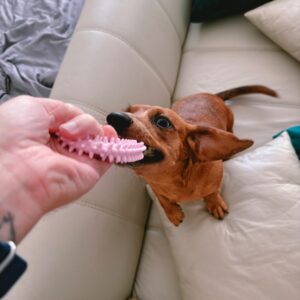Dachshund training basics are essential for every owner looking to build a strong bond with their furry friend. Understanding your Dachshund’s unique traits is fundamental, as these little dogs have distinct personalities and behaviors. In this article, we will explore essential reasons why training is crucial, covering topics such as essential commands every Dachshund should learn, positive reinforcement techniques that make training enjoyable, and tips for effective housebreaking.
Additionally, we will discuss the importance of socialization, providing strategies for handling common behavioral issues, and how to maintain an engaging training environment. Setting a consistent training schedule and using the right toys and treats will also be highlighted to ensure your Dachshund thrives throughout the training process. Finally, we’ll look at how to track your Dachshund’s progress, keeping their journey fun and rewarding.
Understanding Your Dachshund’s Unique Traits

Dachshunds are known for their distinctive appearance and playful personalities. Their long bodies and short legs give them a unique charm that many dog lovers adore. However, beyond their looks, they possess several traits that set them apart from other breeds.
1. Temperament
Dachshunds are often described as curious and bold. They have a strong personality and can be quite stubborn at times. This can make training a bit of a challenge, but with patience, they can learn effectively.
2. Intelligence
This breed is intelligent and quick to learn, but they may not always want to follow commands. Their independent nature means they might think for themselves, which can lead to creative solutions to problems.
3. Energy Levels
Dachshunds are energetic dogs that require regular exercise. They enjoy short walks and playtime, which helps keep them happy and healthy. It’s important to engage them in activities that stimulate both their mind and body.
4. Loyalty and Affection
These dogs are known for their loyalty to their families. They often form strong bonds with their owners and can be very affectionate. This trait makes them great companions for both individuals and families.
5. Sensitivity
Dachshunds can be quite sensitive to their environment. Loud noises or sudden changes can cause anxiety. Providing a calm and stable environment is essential for their well-being.
6. Unique Health Considerations
Due to their long spine, Dachshunds are prone to certain health issues, particularly intervertebral disc disease. It’s crucial for owners to be aware of this and take preventive measures, such as avoiding excessive jumping and maintaining a healthy weight.
Understanding these unique traits will help you build a strong and loving relationship with your Dachshund. Their quirky personalities and loyalty make them a cherished addition to any home.
Essential Commands Every Dachshund Should Learn
Training your Dachshund is essential for a happy and well-behaved pet. Here are some key commands that every Dachshund should learn:
-
- Sit: This is one of the first commands to teach. It helps your dog learn self-control.
-
- Stay: This command is crucial for keeping your Dachshund in place when needed.
-
- Come: Teaching your dog to come when called can keep them safe in various situations.
-
- Down: This command helps your dog settle down and can prevent jumping on people.
-
- Leave it: This command is important for teaching your dog to ignore distractions or potential dangers.
-
- Heel: This command ensures your Dachshund walks nicely beside you on a leash.
-
- Drop it: Teaching your dog to drop items they shouldn’t have can prevent accidents.
By mastering these commands, your Dachshund will not only be well-behaved but also more enjoyable to have around. Remember to use positive reinforcement during training to encourage good behavior!
Positive Reinforcement Techniques for Training
Positive reinforcement is a powerful method for training your dachshund. It involves rewarding good behavior to encourage its repetition. This technique helps build a strong bond between you and your dog while making training enjoyable.
Key Positive Reinforcement Techniques
-
- Verbal Praise: Use a happy tone to praise your dachshund when it performs the desired behavior. Words like “Good boy!” or “Well done!” can motivate your dog.
-
- Treat Rewards: Offer small, tasty treats as a reward for good behavior. Make sure the treats are healthy and suitable for your dachshund.
-
- Clicker Training: A clicker can help mark the exact moment your dog does something right. Follow the click with a treat for effective reinforcement.
-
- Playtime: Use play as a reward. Engaging your dachshund in a fun game can be a great motivator.
-
- Affection: Physical affection, like petting or cuddling, can reinforce good behavior. Dogs thrive on love and attention.
Timing is Crucial
To make positive reinforcement effective, timing is essential. Reward your dachshund immediately after it displays the desired behavior. This helps your dog associate the behavior with the reward.
Be Consistent
Consistency is key in training. Use the same commands and rewards each time. This clarity helps your dachshund understand what is expected.
Gradually Increase Challenges
As your dachshund learns, gradually increase the difficulty of tasks. Start with simple commands and work up to more complex behaviors. Continue to use positive reinforcement to encourage progress.
Monitor Your Dog’s Response
Pay attention to your dachshund’s reactions. If it seems uninterested in rewards, try different treats or methods of reinforcement. Tailoring your approach can lead to better results.
Incorporating these positive reinforcement techniques into your training routine will help your dachshund learn effectively while enjoying the process. Remember, patience and consistency are vital for success!
Housebreaking Your Dachshund: Tips and Tricks
Housebreaking your Dachshund can be a rewarding experience when done correctly. Here are some effective tips and tricks to help you along the way:
Establish a Routine
Dogs thrive on routine. Set specific times for feeding, potty breaks, and walks. This helps your Dachshund learn when it’s time to go outside.
Choose a Designated Potty Area
Pick a specific spot outside for your Dachshund to do its business. This makes it easier for your dog to understand where to go.
Watch for Signs
-
- Pacing: If your Dachshund starts pacing, it may need to go out.
-
- Whining: Whining can indicate that your dog needs a potty break.
-
- Sniffing: If your dog is sniffing around, it might be looking for a place to relieve itself.
Use Commands
When you take your Dachshund outside, use a specific command like “Go potty”. This helps your dog associate the command with the action.
Positive Reinforcement
Always reward your Dachshund with praise or treats after it goes potty outside. This encourages good behavior and reinforces the idea that going outside is a positive experience.
Be Patient
Housebreaking takes time. If your Dachshund has an accident indoors, don’t scold it. Instead, clean it up and try again next time.
Keep a Close Eye
When you’re home, keep an eye on your Dachshund. If you notice signs it needs to go out, take it outside immediately.
Limit Freedom Indoors
Until your Dachshund is fully housebroken, consider using a crate or limiting access to certain areas. This helps prevent accidents and teaches your dog boundaries.
Consistency is Key
Stick to your routine and commands. Consistency will help your Dachshund learn faster and feel more secure.
With these tips and tricks, housebreaking your Dachshund can be a smooth process. Remember to stay patient and positive as you work together!
Socialization: Why It’s Important for Dachshunds
Socialization is a crucial part of raising a well-adjusted Dachshund. It helps them learn how to interact with other dogs, people, and various environments. Proper socialization can prevent behavioral issues and promote a happy, confident dog.
Benefits of Socialization
-
- Reduces Fear: Early exposure to different situations helps reduce fear and anxiety in your Dachshund.
-
- Improves Behavior: Socialized dogs are generally better behaved and more adaptable.
-
- Enhances Confidence: A well-socialized Dachshund is more confident in new situations.
-
- Encourages Play: Socialization encourages healthy play with other dogs.
When to Start Socializing
Start socializing your Dachshund as early as possible. The critical period for socialization is between 3 and 14 weeks of age. During this time, expose them to various experiences, sounds, and people.
Ways to Socialize Your Dachshund
-
- Dog Parks: Visit local dog parks to allow your Dachshund to interact with other dogs.
-
- Training Classes: Enroll in puppy training classes to meet other dogs and learn basic commands.
-
- Public Outings: Take your Dachshund on trips to pet-friendly stores or cafes.
-
- Home Visits: Invite friends and family over to meet your Dachshund, ensuring they are friendly and calm.
Signs of Poor Socialization
Watch for signs that your Dachshund may not be well-socialized, such as:
-
- Excessive Barking: Barking at people or other dogs can indicate fear or anxiety.
-
- Aggression: Growling or snapping can be a sign of insecurity.
-
- Avoidance: Hiding or trying to escape from new experiences can indicate a lack of socialization.
In conclusion, socialization is essential for your Dachshund’s development. By providing positive experiences and exposure to different environments, you can help your dog grow into a well-adjusted and happy companion.
Handling Common Behavioral Issues
Every dachshund owner may face behavioral challenges at some point. Understanding how to address these issues effectively is crucial for a harmonious relationship with your furry friend. Here are some common behavioral problems and ways to handle them:
Excessive Barking
Excessive barking can be frustrating. It often stems from boredom, anxiety, or the need to alert you. To manage this behavior:
-
- Provide regular exercise to tire them out.
-
- Use positive reinforcement to reward quiet behavior.
-
- Teach the “quiet” command to help control barking.
Destructive Chewing
Dachshunds may chew on furniture or shoes when they are bored or anxious. To prevent this:
-
- Offer plenty of chew toys to satisfy their urge.
-
- Redirect them to appropriate items when caught chewing.
-
- Ensure they have enough physical and mental stimulation.
Separation Anxiety
Some dachshunds may experience separation anxiety when left alone. To help them cope:
-
- Gradually increase the time they spend alone.
-
- Provide a safe, comfortable space with their favorite toys.
-
- Consider using calming aids, like a snug blanket or pheromone diffuser.
Jumping on People
Jumping can be an exciting way for dachshunds to greet people, but it’s often unwelcome. To curb this behavior:
-
- Ignore them when they jump and only give attention when they are calm.
-
- Teach them to sit before greeting guests.
-
- Reward them for keeping all four paws on the ground.
Leash Pulling
Leash pulling can make walks challenging. To teach your dachshund to walk nicely on a leash:
-
- Use a no-pull harness to discourage pulling.
-
- Stop walking when they pull and resume when they are calm.
-
- Reward them for walking beside you without pulling.
By addressing these common behavioral issues with patience and consistency, you can foster a positive environment for your dachshund, leading to a happy and well-adjusted pet.
How to Keep Training Fun and Engaging
Training your Dachshund doesn’t have to be a chore. In fact, it can be a fun and rewarding experience for both you and your furry friend. Here are some tips to keep your training sessions lively and enjoyable:
Incorporate Playtime
Make training sessions feel less like work by incorporating play. Use games to teach commands and reinforce learning. For example:
-
- Fetch: Use a favorite toy to practice commands like “come” or “drop it.”
-
- Hide and Seek: Have your Dachshund stay while you hide, then call them to find you.
Vary the Activities
Keep things interesting by mixing up the training activities. Alternate between different commands, tricks, and games to maintain your dog’s attention.
Use Positive Reinforcement
Always reward your Dachshund for their efforts. This can be done through:
-
- Treats: Offer small, tasty treats to celebrate successes.
-
- Praise: Use enthusiastic verbal praise and petting to show approval.
Set Short Sessions
Keep training sessions short and sweet—around 5 to 10 minutes. This helps prevent boredom and keeps your Dachshund engaged.
Incorporate New Tricks
Challenge your Dachshund by teaching them new tricks. This not only stimulates their mind but also strengthens your bond. Consider tricks like:
-
- Roll over
-
- Play dead
-
- Spin
Make It a Family Activity
Involve family members in the training process. This not only makes it more fun but also helps your Dachshund learn to respond to different people.
Celebrate Achievements
Whether big or small, celebrate your Dachshund’s achievements. This can be through a mini party, extra playtime, or a special treat.
By keeping training fun and engaging, you’ll foster a positive learning environment that benefits both you and your Dachshund. Enjoy the journey together!

Setting a Consistent Training Schedule
Establishing a consistent training schedule is crucial for your Dachshund’s success. Regular training sessions help reinforce learning and build a strong bond between you and your pet.
Choose a Suitable Time
Select a time of day when both you and your Dachshund are calm and focused. This could be in the morning or evening, depending on your daily routine. Try to stick to the same time each day to create a habit.
Keep Sessions Short and Engaging
Dachshunds have a short attention span. Aim for training sessions that last about 5 to 10 minutes. This keeps them engaged and prevents boredom.
Incorporate Variety
To keep your Dachshund interested, mix up the training activities. You can include:
-
- Basic commands
-
- Fun tricks
-
- Agility exercises
Be Consistent with Commands
Use the same words and gestures for each command. Consistency helps your Dachshund understand what you expect from them.
Schedule Regular Breaks
After each training session, allow your Dachshund some time to relax. This helps them process what they have learned and prevents them from feeling overwhelmed.
Track Progress
Keep a log of your training sessions to monitor your Dachshund’s progress. Note what works well and any areas that need improvement, so you can adjust your schedule as needed.
By setting a consistent training schedule, you can help your Dachshund learn efficiently while also making the process enjoyable for both of you.
Using Toys and Treats for Effective Training

Training your Dachshund can be a rewarding experience, especially when you use toys and treats as part of the process. These tools can enhance learning and make training sessions enjoyable for both you and your furry friend.
Choosing the Right Toys
Not all toys are created equal when it comes to training. Here are some tips for selecting the best toys:
-
- Durability: Choose toys that can withstand chewing.
-
- Size: Ensure the toy is appropriate for your Dachshund’s size.
-
- Interactive: Look for toys that require your dog to think and engage.
Types of Treats to Use
Treats can be a powerful motivator during training. Consider the following:
-
- Small and Soft: Treats should be easy to chew and swallow quickly.
-
- High-Value Treats: Use special treats for difficult commands or behaviors.
-
- Healthy Options: Choose treats that are nutritious and low in calories.
Incorporating Toys and Treats into Training
Here are some effective methods to use toys and treats during training:
-
- Reward-Based Training: Use treats as rewards for good behavior.
-
- Playtime as a Reward: Incorporate toys as a reward after completing tasks.
-
- Interactive Games: Use toys to create fun games that reinforce commands.
Tips for Successful Training Sessions
To maximize the effectiveness of using toys and treats, keep these tips in mind:
-
- Short Sessions: Keep training sessions brief to maintain your Dachshund’s attention.
-
- Consistency: Use the same toys and treats to create a routine.
-
- Positive Environment: Ensure the training space is free from distractions.
By effectively using toys and treats, you can create a fun and engaging training experience for your Dachshund. This approach not only strengthens your bond but also helps your dog learn essential skills more efficiently.
Tracking Your Dachshund’s Progress in Training
Monitoring your Dachshund’s training journey is essential for ensuring their success and your satisfaction as an owner. Here are some effective ways to keep track of their progress:
-
- Maintain a Training Journal: Write down each training session’s details, including the commands practiced, your dog’s responses, and any challenges faced. This helps you see patterns and improvements over time.
-
- Set Clear Goals: Establish specific, measurable goals for your Dachshund’s training. For example, aim for them to master a command within a certain timeframe.
-
- Use a Progress Chart: Create a visual chart to track your Dachshund’s progress. Mark off when they successfully learn a new command or behavior.
-
- Record Video Sessions: Filming training sessions can help you observe your Dachshund’s behavior and progress. It also allows you to compare their skills over time.
-
- Seek Feedback: If you’re working with a trainer, ask for their input on your Dachshund’s progress. They can provide valuable insights and suggestions for improvement.
By implementing these strategies, you can effectively track your Dachshund’s training progress, making adjustments as necessary to ensure they continue to thrive.




